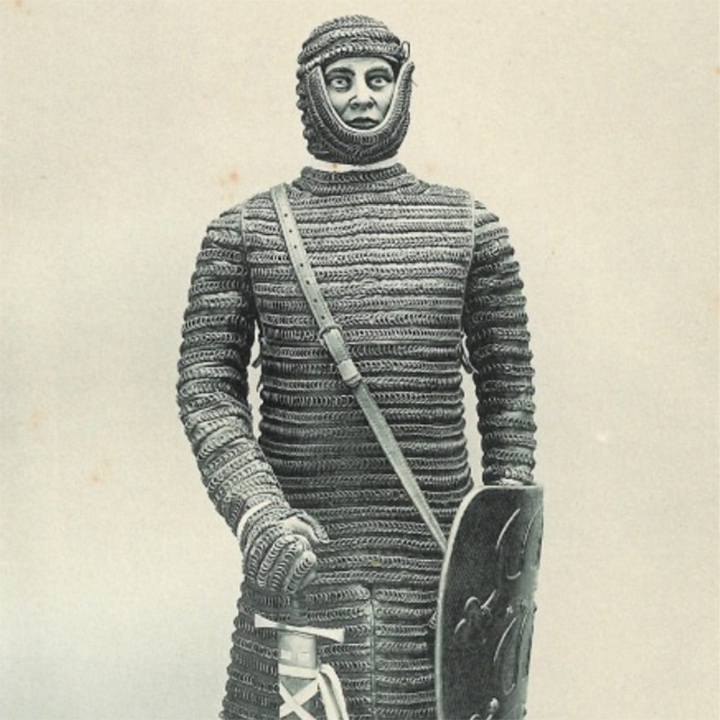
Armor Class 4
the best defense is never to exist in the first place
It should not surprise long-time listeners that I play Dungeons & Dragons.
Actually, scratch that. I love Dungeons & Dragons, and I have ever since the day Alex Eliopoulos shoved some polyhedral dice into my hand and then tricked me into kissing a medusa. I’m an old-school nerd who remembers when (if you were lucky) the new issue of Dragon Magazine would have installments of both Wormy and SnarfQuest in the back. I have forced players to use the weapon speed rules and weapon vs. armor class modifiers from the Player’s Handbook, and then rewarded them for their trouble by handing out the laser pistols and dynamite buried in the first edition Dungeon Masters Guide like they were candy. I have played a jester for more than one session. Zagyg Yragerne is my god, and E. Gary Gygax is his prophet.
Of course, if you love something, you have to love it warts and all. And Dungeons & Dragons has a lot of warts.
So very many warts.
Today we’re going to talk about Armor Class. If you’ve never played a role-playing game, Armor Class is an abstraction that describes not only how hard you are to hit, but how often an attack will penetrate your armor and do damage.
In the First Edition of Advanced Dungeons & Dragons, Armor Class is a number ranging from 10 to -10, with 10 representing a regular person wearing street clothes and -10 representing a Sherman tank made out of adamantium. There’s a handy little table on page 36 of the Player’s Handbook that tells you just how much protection each type of armor provides:
- Armor Class 10 is no armor at all;
- Armor Class 9 is only a shield;
- Armor Class 8 is leather armor;
- Armor Class 7 is studded leather armor or ring mail;
- Armor Class 6 is scale mail;
- Armor Class 5 is chain mail;
- Armor Class 4 is splint mail or banded mail;
- Armor Class 3 is plate mail;
- and anything lower than that involves using armor and a shield or magic or possibly both.
At this point anyone who’s ever made a study of historical arms and armor is champing at the bit to bust out the old “um, actually” because D&D creator E. Gary Gygax had picked up several bad habits from the out-of-date materials available to him at the time. Here’s a perfect example: Gygax calls all metal armor “mail” even though mail specifically means armor made out of tiny interlinked chains or rings. (That also makes the term “chain mail” redundant, but we tend to let that slide because it’s become ubiquitous.)
Pedantry aside, there’s also some weird doubling up happening. For instance, Armor Class 7 is provided by both studded leather armor and ring mail. This seeming redundancy is explained when you look at other game mechanics:
- Some characters can only wear leather armor.
- There are monsters and spells which affect leather but not metal and vice versa.
- Ring mail is considerably more expensive and heavier than leather armor.
So, someone shooting for Armor Class 7 has to weigh the various tradeoffs. Do I go with the cheap leather armor that might be dissolved right off my back by a puddle of green slime? Do I go with the expensive ring mail that will drag me to my doom when I get knocked into a water-filled pit?
There’s another redundancy further down at Armor Class 4 but this one’s a bit harder to explain. Banded mail and splint mail are both metal, and there’s no type of character which can wear one but not the other. To make matters worse banded mail is clearly superior to splint mail almost every way, because it weighs less and allows freedom of movement. Its only downside is that it costs twice as much — which isn’t nothing, but is a meaningless distinction for anyone other than a brand new character. So why are they both on the list?
Maybe we can figure it out if we read the descriptions of banded mail and split mail. In a typical move for Advanced Dungeons & Dragons, the armor descriptions are not in the equipment section of Player’s Handbook where they might actually be useful, but are instead buried somewhere in the bloated mess that is the Dungeon Master’s Guide. Let’s see, armor, armor, ah! Right where it should be on page 27, sandwiched between the reputed properties of magical gemstones and how much it costs to hire a torchbearer for a week.
Banded Mail is a layered armor with padding, light chain, and a series of overlapping bands of armor in vulnerable areas. Weight is somewhat distributed.
Splint mail consists of a light chain, greaves, and a leather coat into which are laminated vertical pieces of plate with shoulder guards.
So… a chain shirt of some sort, a leather or padded undershirt, and reinforcement provided by patches of metal bands. They sound pretty identical to me. If we’re going to get to the bottom of this, we’re going to have to look somewhere else.
So What Is Banded Mail, Exactly?
Maybe we should start with the sort of sources E. Gary Gygax would have on hand, scholarly books on arms and armor from the Nineteenth Century. What do they have to say?
Splint mail or splinted mail seems to have been scale armor or mail with additional limb protection provided by long metal strips riveted or linked to the base — metal pinstripes, basically. That explains why Gygax thinks it would be cumbersome and slow.
Banded mail, though… well, the sources are a bit more confused there.
The usual body-armour of the knightly order was, in the early part of the thirteenth century, of interlinked chain-mail; but in the second half of the century, portions of plate appear, in the form of shoulder-pieces, elbow-pieces, and knee-pieces… and, at the close of the century, a kind of armour which has been named Banded-mail, but of which the structure has not been exactly ascertained.
John Hewitt, Ancient Armor and Weapons in Europe
Both the knight and the ordinary soldier appeared in it, and it is represented constantly in illustrations of the period and occurs on any brasses and effigies; and yet at the present time we are ignorant of its nature… No actual specimens of this defence have been preserved to the present time.
Charles Henry Ashdown, Armor & Weapons in the Middle Ages
Arms, legs and body were encased in interlinked chain armour, under which it was essential to wear thick padded garments, and often this mail was made more rigid and less pliable by the addition of leather which has come to be known as “banded mail,” a fabric which has puzzled all antiquaries for nearly a century without reaching a satisfactory explanation…
Charles Ffloulkes, “Some Criticism of Military Equipment 1066-1900”
Of the many subjects of perplexity to the student of ancient armor, there is none so puzzling as that of banded mail. And yet the representations of it are in the utmost abundant… By many writers it has been described as pour-pointerie; by others this peculiar work has been considered only as a conventional mode of representing the ordinary chain mail.
John Hewitt, “Effigies of the De Sulneys, at Newton Solney, Derbyshire
The problem appears to be that no one has ever seen a suit of banded mail in real life. That isn’t terribly surprising. A good suit of armor is too useful to lie moldering in a nobleman’s grave; when it does get used it tends to get extensively damaged; and when it’s no longer useful it gets melted down so the metal can be recycled.
We’ll just have to figure out what banded mail is from what we do have, which are illustrations.
They seem to depict suits of armor made from thick horizontal bands of semicircles in alternating directions, usually with a line between them. The material seems to be flexible and cloth-like, hugging the body tight in some areas and draping and folding in others. The illustrations give us no clues to how this armor is supposed to be constructed, so antiquarians have had to make educated guesses.
Or, perhaps more to the point, uneducated guesses.
One idea was that banded mail was a form of piecemeal plate armor similar to the Roman lorica segmentata, which sounds good except for the fact that’s not what the illustrations depict at all.
Another idea was that banded mail consisted of hammered metal discs attached to a quilted gambeson or leather coat. It is not clear why this would be better than say, a suit of plate. The overlapping discs waste a lot of precious material, are extremely heavy, and not terribly flexible. The illustrations also show the discs or rings on the reverse of the armor, implying it wasn’t just single-sided.
One popular suggestion was that banded mail was mail with thin leather thongs drawn through the links in alternating directions to create a distinctive pattern. That makes some sense; a similar technique was often used to stiffen the collars and cuffs of mail shirts and coats. You wouldn’t want to make an entire suit of armor that way, though, because it would be too stiff to move in. Some non-European armors like the Persian begter or the Russian bechterets, do use a similar method but they are not horizontal bands of rings, but vertical strips of plates hanging loosely. There’s the problem that it looks utterly ridiculous. A few modern armorers have created “banded mail” using this method and it makes the wearer look bloated and puffy, like Ralphie’s little brother from A Christmas Story or like they were trying to LARP as the Michelin Man. It would also be ridiculously expensive to make and almost impossible to maintain.
The most popular suggestion, though, was that banded mail never existed at all, that it was a shorthand for artists and illustrators. As an artist, this makes perfect sense to me. Who wants to go mad and develop carpal tunnel from drawing something like a mail shirt with a complicated and repetitive pattern? George Perez, maybe, but the rest of us? We’re going to break that complicated pattern down into some suggestive brush scrumblings, a series of simple loops, or alternating rows of semicircles.
Of course, that raises the question of why banded mail exists as a classification at all. Surely no one would be so stupid as to mistake artistic shorthand for actual reality. I mean, no one could look at something hyper-stylized like the Bayeux Tapestry and conclude it was supposed to be a 100% accurate, literal representation of period arms and armor, right?
Right?
Let me introduce you to antiquarian Samuel Rush Meyrick. His 1824 book A Critical Enquiry into Antient Armour as It Existed in Europe, But Particularly in England, from the Norman Conquest to the Reign of King Charles II, With A Glossary of Military Terms of the Middle Ages was one of the first series attempts to study and classify medieval arms and armor and was hugely influential.
The problem was that while working alone Meyrick had fallen deep into the chasm of his own insane troll logic and became convinced that illustrations with different types of patterning were different types of armor. This set of armor is drawn with crosshatching at a right angle, and this set of armor is drawn with crosshatching at an oblique angle? Why they must be two different types of armor! This coat of mail is drawn with tiny rings, and this one with big rings? Two different types of armor!
Meyrick’s books are filled with spurious classifications like mascled mail (lozenge-shaped metal plates sewn to a leather coat); trellised mail (square plates inserted between layers of leather and riveted into place); rustred mail (made of overlapping but not interlocking rings); and tegulated mail (metal plates hung in a pattern that resembles a child’s drawing of a brick wall). None of them existed outside of his own fevered imagination. Banded mail was another one of his “discoveries.”
That would seem to end the debate right there, no? Clearly the lazy artist theory wins. QED.
Except…
Antiquarians like Charles Ffoulkes raise one troubling issue: if banded mail is just a visual shorthand for chainmail, why are illustrations of banded mail often paired with more conventional depictions of chainmail?
It’s true. Images of knights and soldiers wearing coats of banded mail often show them wearing normal-looking mail hoods and cowls. If you were taking shortcuts, why would you mix and match patterns like that? It creates just enough doubt that you can’t call the argument settled.
In the end the answer to the question “What is banded mail?” winds up being, “We don’t know (probably nothing).”
Whither Banded Bail
Let’s get back to our original question: what does this mean for Dungeons & Dragons?
In 1987 Alan Ristow wrote a letter to Dragon Magazine outlining the history of banded mail and suggesting that it be removed from the game for the sake of historical accuracy, or if that wasn’t feasible, tweaking banded mail and splint mail so that there were meaningful differences between them.
Ristow’s letter started a kerfuffle in the Dungeons & Dragons fan community… well, what passed for a kerfuffle in those days before the Internet. For several years the topic was vigorously debated in letters pages and fanzines. A small group of writers argued that removing banded mail from the game meant you were no longer using the rules-as-written and therefore not playing “real D&D.” Many more responded that the first group were joyless grognards and argued that you should be free to do whatever you wanted. Some agreed with Ristow that historical accuracy was important, and others quite reasonably pointed out that historical accuracy was a weird hill to die on when you are playing a game where elf wizards and dwarf warriors use magic swords and lightning bolts to fight demons, devils, dragons, and drow.
TSR eventually decided to deal with the debate by ignoring it. The editors of Dragon added banded mail to their list of prohibited topics, putting it in the rarified company of what would happen if you turned someone into a worm, cut them in half, let both halves regrow, then changed them back; here’s how my character took down the ultra-powerful wizard Waldorf; and do female dwarves have beards.
Two years later the Second Edition of Dungeons & Dragons made no significant changes to the armor rules.
A decade after that, the Third Edition of Dungeons & Dragons made major changes to the rules of the game. The new armor rules had more fiddly bits like “maximum Dexterity bonus” and “armor check penalty” and “arcane spell failure chance” that could be used to differentiate banded mail and splint mail. The designers rather pointedly chose not to do that, and once again banded mail was superior to split mail in every way save for a trivial difference in price. At least they finally cleared up a lot of confusion as to what banded mail was supposed to be with the following expanded description:
This suit includes gauntlets.
There was also an accompanying illustration, which bore absolutely no resemblance to historical depictions of banded mail.
I, myself, tend to prefer the approach taken in the Fourth and Fifth Editions of Dungeons & Dragons: they just got rid of banded mail entirely. Gone. Poof. No replacement was necessary, because there were still plenty of other armor options if you wanted some variety.
And you know what? There was no controversy. Nobody missed banded mail at all. Because it’s impossible to miss something that never existed in the first place.
Connections
For more tales of dungeons and/or dragons, be sure to check out the strange story of Waldorf (“Grandiose but Straightforward”) and the history of the utterly useless 30-sided die (“The Die of Tomorrow, Today”).
Sources
- Ashdown, Charles Henry. Armour & Weapons in the Middle Ages. London: Harrap, 1925.
- Bull, Stephen. An Historical Guide to Arms & Armor. New York: Facts on File, 1991.
- Camp, S.J. “Seven Centuries of European Armour and Arms.” The Burlington Magazine for Connoisseurs, Volume 36, Number 205 (April 1920).
- Cook, David “Zeb”. Advanced Dungeons & Dragons Player’s Handbook (Second Edition). Lake Geneva: TSR, 1989.
- Cordell, Bruce et. al. Dungeons & Dragons Player’s Handbook (Fifth Edition). Renton, WA: Wizards of the Coast, 2014.
- Dean, Bashford. “A Thirteenth Century Marble Relief from Poblet.” The Metropolitan Museum of Art Bulletin, Volume 8, Number 8 (August 1913).
- Edge, Davis and Paddock, John Miles. Arms and Armor of the Medieval Knight: An Illustrated History of Weaponry in the Middle Ages. Greenwich, CT: Bison Books, 1988.
- Fairholt, Frederick William. Costume in England: A History of Dress from the Earliest Period till the Close of the Eighteenth Century. London: Chapman and Hall, 1856.
- Ffoulkes, Charles John. The Armourer and His Craft from the XIth to the XVIth Century. London: Methuen & Co., 1912.
- Ffoulkes, Charles John. “Some Criticism of Military Equipment 1066-1900.” Journal of the Society for Army Historical Resesarch, Volume 18, Number 71 (Autumn 1939).
- Fliegel, Stephen N. Arms & Armor. Cleveland: Cleveland Museum of Art, 2007.
- Gygax, E. Gary. Advanced Dungeons & Dragons Player’s Handbook. Lake Geneva, WI: TSR Games, 1978.
- Gygax, E. Gary. Advanced Dungeons & Dragons Dungeon Masters Guide. Lake Geneva, WI: TSR Games, 1979.
- Heinsoo, Rob et al. Dungeons & Dragons Player’s Handbook (Fourth Edition). Renton, WA: Wizards of the Coast, 2008.
- Hewitt, John. “Effigies of the De Sulneys, at Newton Solney, Derbyshire.” The Archaeological Journal, Volume 7 (1850).
- Hewitt, John. Ancient Armor and Weapons in Europe, from the Iron Period o the Norther Nations to the End of the Seventeenth Century. Oxford: John Henry and James Parker, 1860.
- Hoopes, Thomas T. “Armor and Arms.” Bulletin of the City Art Museum of St. Louis, Volume 38, Number 3/4 (1954).
- Klučina, Petr. Armor: From Ancient to Modern Times. New York: Barnes and Noble, 1997
- Meyrick, Samuel Rush. A Critical Enquiry into Antient Armour As It Existed in Europe, But Particularly in England, from the Norman Conquest to the Reign of King Charles II, With A Glossary of Military Terms of the Middle Ages (Volumes 1-3). London: Robert Jennings, 1824.
- Tweet, Jonathan et. al. Dungeons & Dragons Player’s Handbook (Third Edition). Renton, WA: Wizards of the Coast, 2006.
- “Apocryphal Armour.” Middenmurk. https://middenmurck.blogspot.com/2015/09/apocryphal-armour.html Accessed 9/30/2023.
- “Banded mail.” Wikipedia. https://en.wikipedia.org/wiki/Banded_mail Accessed 6/7/2023.
- “Forum.” Dragon Magazine, Volume 12, Number 2 (July 1987).
- “Forum.” Dragon Magazine, Volume 12, Number 5 (October 1987).
- “Forum.” Dragon Magazine, Volume 12, Number 10 (March 1988).
Categories
Tags
Published
First Published:
Last Edited:


